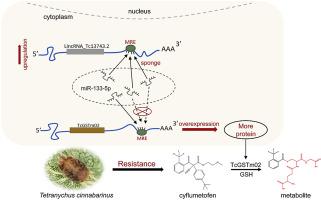Insect Biochemistry and Molecular Biology ( IF 3.2 ) Pub Date : 2020-06-11 , DOI: 10.1016/j.ibmb.2020.103413 Kaiyang Feng 1 , Jie Liu 1 , Peng Wei 1 , Shiyuan Ou 1 , Xiang Wen 1 , Guangmao Shen 1 , Zhifeng Xu 1 , Qiang Xu 2 , Lin He 1

|
Differential expression of metabolic detoxification enzymes is an important mechanism involved in pesticide/acaricide resistance of mite pests. The competing endogenous RNA hypothesis offers a new opportunity to investigate post-transcriptional regulation of those genes. In this study, 4454 long non-coding RNAs were identified in the carmine spider mite Tetranychus cinnabarinus by transcriptome sequencing. Software-based predictions indicated that a long intergenic non-coding RNA, (lincRNA)_Tc13743.2 and a detoxification enzyme gene, TcGSTm02, both contained a microRNA (miR-133-5p) response element. Over-expression of lincRNA_Tc13743.2 and TcGSTm02 were detected in a cyflumetofen-resistant T. cinnabarinus strain (CyR), whereas down-regulation of miR-133-5p was observed in this strain. Conversely, up-regulation of miR-133-5p could inhibit TcGSTm02 expression levels, and both lincRNA_Tc13743.2 and TcGSTm02 were significantly enriched in miR-133-5p biotin–avidin pull-down assays. RNA-binding protein immunoprecipitation assay showed that lincRNA_Tc13743.2 and TcGSTm02 bound to a silencing complex containing miR-133-5p. Moreover, a luciferase reporter assay based on a human cell line revealed that over-expression of lincRNA_Tc13743.2 could significantly reduce the inhibition exerted by miR-133-5p through the TcGSTm02 3′UTR. In addition, co-localization of lincRNA_Tc13743.2 and miR-133-5p was detected using fluorescence in situ hybridization, suggesting that lincRNA_Tc13743.2 interacts directly with miR-133-5p in spider mites. More importantly, silencing the expression of lincRNA_Tc13743.2 significantly reduced the expression levels of TcGSTm02 and increased the sensitivity of spider mites to cyflumetofen. Our data show that lincRNA_Tc13743.2 up-regulates TcGSTm02 expression by competing for miR-133-5p binding, demonstrating that a lincRNA_Tc13743.2–miR-133-5p–TcGSTm02 pathway mediates cyflumetofen resistance in mites.
中文翻译:

lincRNA_Tc13743.2-miR-133-5p-TcGSTm02调控途径介导了朱砂叶螨的氟氰菊酯抗性。
代谢解毒酶的差异表达是螨虫抗农药/杀螨剂的重要机制。竞争性内源性RNA假说为研究这些基因的转录后调控提供了新的机会。在这项研究中,通过转录组测序在胭脂红蜘蛛螨朱砂叶螨中鉴定出4454个长非编码RNA 。基于软件的预测表明,一个长的基因间非编码RNA(lincRNA)_Tc13743.2和一个解毒酶基因TcGSTm02都包含一个microRNA(miR-133-5p)反应元件。lincRNA_Tc13743.2和TcGSTm02的过表达在耐氟尿嘧啶的朱砂巴氏杆菌(CyR)菌株中检测到miR-13,而在该菌株中观察到miR-133-5p的下调。相反,miR-133-5p的上调可抑制TcGSTm02的表达水平,并且miR-133-5p生物素-亲和素下拉测定法显着丰富了lincRNA_Tc13743.2和TcGSTm02。RNA结合蛋白免疫沉淀试验表明,lincRNA_Tc13743.2和TcGSTm02与包含miR-133-5p的沉默复合物结合。此外,基于人类细胞系的萤光素酶报告基因检测表明,lincRNA_Tc13743.2的过表达可以显着降低miR-133-5p通过TcGSTm02 3'UTR产生的抑制作用。此外,使用荧光原位杂交技术检测到了lincRNA_Tc13743.2和miR-133-5p的共定位,这表明lincRNA_Tc13743.2与红蜘蛛中的miR-133-5p直接相互作用。更重要的是,沉默的表达lincRNA_Tc13743.2显著减少的表达水平TcGSTm02和增加的叶螨的灵敏度丁氟螨酯。我们的数据表明,lincRNA_Tc13743.2通过竞争miR-133-5p结合来上调TcGSTm02表达,表明lincRNA_Tc13743.2 –miR-133-5p– TcGSTm02途径介导了螨对氟氰菊酯的抗药性。











































 京公网安备 11010802027423号
京公网安备 11010802027423号